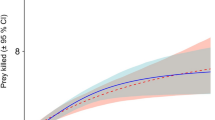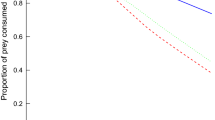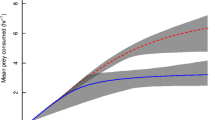Abstract
Peacock basses (genus Cichla) are a group of Amazonian predatory fishes that invaded many systems worldwide. Severe ecological impacts have been reported, but no study investigated the functional response of these fishes to variations in prey abundance, a crucial information to determine predator consumption and impact. In this study, we evaluated the functional response of the highly invasive Cichla kelberi toward prey species of different taxonomic groups, and compared it to the response of the wolf fish Hoplias malabaricus, a voracious predator used as baseline. We hypothesized that higher feeding rates drive the predatory impact of the invasive predator. Using a non-replacement experimental setup, we manipulated prey densities (fish and shrimp) in 1000-L mesocosm tanks to quantify the consumption response of each predator during 24 h. Both predators consumed more fish than shrimp, but C. kelberi consumed significantly more than H. malabaricus. We found that C. kelberi consistently displayed higher Type-II functional response than H. malabaricus toward both prey species. There was a non-significant effect of predator species on attack rates, but C. kelberi presented significantly lower handling time values and higher maximum feeding rates. Our findings provide empirical evidence that high individual consumption rates explain the predatory impact of the highly invasive C. kelberi, and predict strong effects on invaded communities.


Similar content being viewed by others
References
Agostinho, A. A., L. C. Gomes & F.M. Pelicice, 2007. Ecologia e Manejo de Recursos Pesqueiros em Reservatórios do Brasil. EDUEM, Maringá.
Alexander, M. E., J. T. A. Dick, N. E. O’Connor, N. R. Haddaway & K. D. Farnsworth, 2012. Functional responses of the intertidal amphipod Echinogammarus marinus: effects of prey supply, model selection and habitat complexity. Marine Ecology Progress Series 468: 191 −202.
Alexander, M. E., J. T. A. Dick, O. L. F. Weyl, T. B. Robinson & D. M. Richardson, 2014. Existing and emerging high impact invasive species are characterized by higher functional responses than natives. Biology Letters 10: 20130946.
Attayde, J. L., J. Brasil & R. A. Menescal, 2011. Impacts of introducing Nile tilapia on the fisheries of a tropical reservoir in North‐eastern Brazil. Fisheries Management and Ecology 18: 437–443.
Barrios-O’Neill, D., J. T. A. Dick, A. Ricciardi, H. J. MacIsaac & M. C. Emmerson, 2014. Deep impact: in situ functional responses reveal context-dependent interactions between vertically migrating invasive and native mesopredators and shared prey. Freshwater Biology 59: 2194–2203.
Birck, T., H. J. Message, G. Baumgartner, N. Y. Sebastien & D. Baumgartner. 2019. Foraging behavior interactions between the invasive Nile Tilapia (Cichliformes: Cichlidae) and three large native predators. Neotropical Ichthyology 17(3): e180116.
Bistoni, M. A., J. G. Haro & M. Gutierrez. 1995. Feeding of Hoplias malabaricus in the wetlands of Dulce river (Cordoba, Argentina). Hydrobiologia 316: 103-107.
Bovy, H. C., D. Barrios-O’Neill, M. C. Emmerson, D. C. Aldridge & J. T. A. Dick, 2015. Predicting the predatory impacts of the “demon shrimp” Dikerogammarus haemobaphes, on native and previously introduced species. Biological Invasions 17: 597−607.
Britton, R. & M. L. Orsi, 2012. Non-native fish in aquaculture and sport fishing in Brazil: economic benefits versus risks to fish diversity in the upper River Paraná Basin. Reviews in Fish Biology and Fisheries 22: 555−565.
Carvalho, L. N., C. H. V. Fernandes & V. S. S. Moreira. 2002. Alimentação de Hoplias malabaricus (Bloch, 1794) (Osteichthyes, Erythrinidae) no rio Vermelho, Pantanal Sul Mato-Grossense. Revista Brasileira de Zoociências 4(2): 227-236.
Corrêa, F., Claudino, M. C., Bastos, R. F., Huckembeck, S. & A. M. Garcia, 2012. Feeding ecology and prey preferences of a piscivorous fish in the Lagoa do Peixe National Park, a Biosphere Reserve in Southern Brazil. Environmental Biology of Fishes 93: 1–12.
Crookes, S., E. M. DeRoy, J. T. A. Dick & H. J. MacIsaac, 2019. Comparative functional responses of introduced and native ladybird beetles track ecological impact through predation and competition. Biological Invasions 21: 519−529.
Dick, J. A., K. Gallagher, S. Avlijas, H. C. Clarke, S. E. Lewis, S. Leung, D. Minchin, J. Caffrey, M. E. Alexander, C. Maguire, C. Harrod, N. Reid, N. R. Haddaway, K. D. Farnsworth, M. Penk & A. Ricciardi, 2013. Ecological impacts of an invasive predator explained and predicted by comparative functional responses. Biological Invasions 15: 837−846.
Dick, J. T. A., M. E. Alexander, J. M. Jeschke, A. Ricciardi, H. J. MacIsaac, T. B. Robinson, S. Kumschick, O. L. F. Weyl, A. M. Dunn, M. J.Hatcher, R. A. Paterson, K. D. Farnsworth& D. M. Richardson, 2014. Advancing impact prediction and hypothesis testing in invasion ecology using a comparative functional response approach. Biological Invasions 16: 735–753
Dick, J. T. A., M. E. Alexander, A. Ricciardi, C. Laverty, P. O. Downey, M. Xu, J. M. Jeschke, W. C. Saul, M. P. Hill, R. Wasserman, O. L. F. Weyl & R. H. Shaw, 2017. Functional responses can unify invasion ecology. Biological Invasions 19: 1667−1672.
Espínola, L. A., C. V. Minte-Vera & H. F. Júlio Junior. 2010. Invasibility of reservoirs in the Paraná Basin, Brazil, to Cichla kelberi Kullander and Ferreira. Biological Invasions 12: 1873- 1888.
Ferrareze, M. & M. G. Nogueira, 2015. Impact assessment of the introduction of Cichla kelberi in a large Neotropical reservoir and its lateral lagoons (Upper Paraná River Basin, Brazil). Brazilian Journal of Biology 75: 1018−1026.
Franco, A. C., L. N. Santos, A. C. Petry & E. García-Berthou. 2018. Abundance of invasive peacock bass increases with water residence time of reservoirs in southeastern Brazil. Hydrobiologia 817: 155–166.
Fraser, D. F. & J. F Gilliam, 1992. Nonlethal impacts of predator invasion: facultative suppression of growth and reproduction. Ecology 73: 959–970.
Freitas, R. H. A. & G. L. Volpato. 2008. Behavioral response of Nile tilapia to an allopatric predator. Marine and Freshwater Behaviour and Physiology 41(4): 267–272.
Fobert, E., P. Meining, A. Colotelo, C. O’Connor & S. J. Cooke, 2009. Cut the line or remove the hook? An evaluation of sublethal and letal endpoints for deeply hooked bluegill. Fisheries Research 99: 38–46.
Fugi, R., K. D. G. Luz-Agostinho & A. A. Agostinho, 2008. Trophic interaction between an introduced (peacock bass) and a native (dogfish) piscivorous fish in a Neotropical impounded river. Hydrobiologia 607: 143–150.
Gallardo, B., M. Clavero, M. I. Sanchez & M. Vilà, 2016. Global ecological impacts of invasive species in aquatic ecosystems. Global Change Biology 22: 151−163.
Gancedo, B. J. & R. B. Ituarte. 2018. Responses to chemical cues indicative of predation risk by the freshwater shrimp Palaemon argentines (Nobili, 1901) (Caridea: Palaemonidae). Journal of Crustacean Biology 38(1): 8–12.
Gilliam, J. F., D. F. Fraser& M. Alkins-Koo, 1993. Structure of a tropical stream fish community: a role for biotic interactions. Ecology 74: 1856–1870.
Gomiero, L. M. & F. M. S. Braga. 2004. Feeding of introduced species of Cichla (Perciformes, Cichlidae) in Volta Grande reservoir, river Grande (MG/SP). Brazilian Journal of Biology 64(4): 787-795.
Iacarella, J. C., J. T. A. Dick, M. E. Alexander& A. Ricciardi, 2015. Ecological impacts of invasive alien species along temperature gradients: testing the role of environmental matching. Ecological Applications, 25: 706−716.
Jepsen, D. B., K. O. Winemiller & D. C. Taphorn, 1997. Temporal patterns of resource partitioning among Cichla species in a Venezuelan blackwater river. Journal of Fish Biology 51: 1058−1108.
Juliano, S. A., 2001. Nonlinear curve fitting: predation and functional curves. In Scheiner, S. M. & J. Gurevitch(eds). Design and Analysis of Ecological Experiments. Oxford University Press, New York: 178–196.
Khan, F. & P. Panikkar, 2009. Assessment of impacts of invasive fishes on the food web structure and ecosystem properties of a tropical reservoir in India. Ecological Modelling 220: 2281–2290.
Kovalenko, K. E., E. D. Dibble, A. A. Agostinho & F. M. Pelicice, 2010a. Recognition of non-native peacock bass, Cichla kelberi by native prey: testing the naiveté hypothesis. Hydrobiologia 12: 3071−3080.
Kovalenko, K. E., E. D. Dibble, A. A. Agostinho, G. Cantanhêde & R. Fugi, 2010b. Direct and indirect effects of an introduced piscivore, Cichla kelberi and their modification by aquatic plants. Hydrobiologia 638: 245−253.
Latini, A. O. & M. Petrere Jr. 2004. Reduction of a native fish fauna by alien species: na example from Brazilian freshwater tropical lakes. Fisheries Management and Ecology 11(2): 71-79.
Laverty, C., J. T. A. Dick, M. E. Alexander& F. E. Lucy, 2015. Differential ecological impact of invader and native predatory freshwater amphipods under environmental change are revealed by comparative functional responses. Biological Invasions 17: 1761−1770.
Luiz, T. F., M. R. Velludo, A. C. Peret, J. L. R. Filho A. M. Peret. Diet, reproduction and population structure of the introduced Amazonian fish Cichla piquiti (Perciformes: Cichlidae) in the Cachoeira Dourada reservoir (Paranaíba River, Central Brazil). Revista de Biologia Tropical 59: 727-741.
Marshall, B. E. 2018. Guilty as charged: Nile perch was the cause of the haplochromine decline in Lake Victoria. Canadian Journal of Fisheries and Aquatic Sciences 75: 1542–1559.
Marto, V. C. O., A. Akama & F. Pelicice, 2015. Feeding and reproductive ecology of Cichla piquiti Kullander & Ferreira, 2006 within its native range, Lajeado reservoir, rio Tocantins basin. Neotropical Ichthyology 13: 625−636.
Mazzeo, N., C. Iglesias, F. T. Mello, A. Borthagaray,C. Fosalba, R. Ballabio, D. Larrea, J. Vilches, S. García,J. P. Pacheco & E. Jeppesen, 2010. Trophic cascade effects of Hoplias malabaricus (Characiformes, Erythrinidae) in subtropical lakes food webs: a mesocosm approach. Hydrobiologia 644: 325–335.
Mendonça, H. S., A. C. A. Santos, M. M. M. Martins & F. G. Araújo, 2018. Size-related and seasonal changes in the diet of the non-native Cichla kelberi Kullander & Ferreira, 2006 in a lowland reservoir in the southeastern Brazil. Biota Neotropica 18: e20170493.
Menezes, R. F., J. L. Attayde, G. Lacerot, S. Kosten, L. C. Souza, L. S. Costa, E. H. Van Nes & E. Jeppesen. 2012. Lower biodiversity of native fish but only marginally altered plankton biomass in tropical lakes hosting introduced piscivorous Cichla cf. ocellaris. Biological Invasions 14: 1353-1363.
Moustahfid, H., M. C.Tyrrell, J. S. Link, J. A. Nye, B. E. Smith & R. J. Gamble, 2010. Functional feeding responses of piscivorous fishes from the northeast US continental shelf. Oecologia 163: 1059−1067.
Novaes, J. L. C., E. P. Caramaschi & K. O. Winemiller. 2004. Feeding of Cichla monoculus Spix, 1829 (Teleostei: Cichlidae) during and after reservoir formation in the Tocantins river, Central Brazil. Acta Limnologica Brasiliensia 16(1): 41-49.
Okun, N., J Brasil, J. L. Attayde & I. A. S. Costa, 2007. Omnivory does not prevent trophic cascades in pelagic food webs. Freshwater Biology 53: 129–138.
Paterson, R. A., J. A. Dick, D. W. Pritchard, M. Ennis, M. J. Hatcher, 2015. Predicting invasive species impacts: a community module functional response approach reveals context dependencies. Journal of Animal Ecology 84: 453–463.
Pelicice, F. M. & A. A. Agostinho, 2009. Fish fauna destruction after the introduction of non-native predator (Cichla kelberi) in a Neotropical reservoir. Biological Invasions 11: 1789−1801.
Pelicice, F. M., J. D. Latini & A. A. Angelo, 2015. Fish fauna disassembly after the introduction of a voracious predator: main drivers and the role of the invader’s demography. Hydrobiologia 746: 271−283.
Pelicice, F. M., V. M. Azevedo-Santos, A. D. L. Esguícero, A. A. Agostinho & M. S. Arcifa. 2018. Fish diversity in the cascade of reservoirs along the Paranapanema River, southeast Brazil. Neotropical Ichthyology 16(2): e170150.
Petry, A. C., L. C. Gomes, P. A. Piana & A. A. Agostinho, 2010. The role of predatory trahira (Pisces: Erythrinidae) in structuring fish assemblages in lakes of a Neotropical floodplain. Hydrobiologia 651: 115−126.
Pompeu, P.S. & A. L. Godinho. 2001. Mudança na dieta da traíra Hoplias malabaricus (Bloch) (Erythrinidae, Characiformes) em lagoas da bacia do rio Doce devido à introdução de peixes piscívoros. Revista Brasileira de Zoologia 18(4): 1219–1225.
Pritchard, D. W., R. A. Paterson, H. C. Bovy & D. Barrios-O’Neill, 2017. FRAIR: an R package for fitting and comparing consumer functional responses. Methods in Ecology and Evolution 8: 1528–1534.
Rogers, D. J., 1972. Random search and insect population models. Journal of Animal Ecology 41: 369–383.
Santos, L. N., A. F. Gonzales & F. G. Araújo. 2001. Dieta do tucunaré-amarelo Cichla monoculus (Bloch & Schneider) (Osteichthyes, Cichlidae), no reservatório de Lajes, Rio de Janeiro, Brasil. Revista Brasileira de Zoologia 18: 191–204.
Sharpe, D. M. T., L. F. De León, R. González & M. E. Torchin. 2017. Tropical fish community does not recover 45 years after predator introduction. Ecology 98(2): 412-424.
Strayer, D. L., 2010. Alien species in fresh waters: ecological effects, interactions with other stressors, and prospects for the future. Freshwater Biology 55: 152–174.
Taylor, N. G. & A. M. Dunn, 2018. Predatory impacts of alien decapod Crustacea are predicted by functional responses and explained by differences in metabolic rate. Biological Invasions 20: 2821−2837.
Turesson H., A. Persson & C. Brönmark, 2002. Prey size selection in piscivorous pikeperch Stizostedion lucioperca) includes active prey choice. Ecology of Freshwater Fish 11: 223–233.
Valverde, M. P., D. M. P. Sharpe, M. E. Torchin, D. F. Buck & L. J. Chapman. 2020. Trophic shifts in a native predator following the introduction of a top predator in a tropical lake. Biological Invasions 22: 643–661.
Witte F., T. Goudswaard, E. F. B. Katunzi, O. C. Mkumbo, O. Seehausen & J. H. Wanink, 1999. Lake Victoria’s ecological changes and their relationships with the riparian societies. In Kawanabe H., G.W. Coulter & A. C. Roosevelt(eds), Ancient Lakes: Their Cultural and Biological Diversity. Kenobi Productions, Belgium: 189–202.
Witte, F., T. Goldschmidt, J. Wanink, M. van Oijen, K. Goudswaaed, E. W. Maas & N. Bouton, 1992. The destruction of an endemic species flock: quantitative data on the decline of the haplochromine cichlids of Lake Victoria. Environmental Biology of Fishes 34: 1–28.
Xu, M., X. Mu, J. T. A. Dick, M. Fang, D. Gu, D. Luo, J. Zhang, J. Luo & Y. Hu, 2016. Comparative functional responses predict the invasiveness and ecological impact of alien herbivorous snails. PLoS ONE 11: e0147017.
Zaret, T. M. & R. T. Paine, 1973. Species introduction in a tropical lake. Science 82: 449–455.
Acknowledgements
We thank the staff at the Laboratório de Ecologia de Comunidades e Paisagens and Setor de Aquicultura from the Universidade Federal Rural do Semi-Árido for helping with field sampling and experimental conduction. We also thank Weferson Júnio da Graça (Museu Ictiológico Universidade Estadual de Maringá) for revising the taxonomic identification of C. kelberi (voucher ID: NUP 18049). José Luis Attayde (UFRN) and an anonymous reviewer provided helpful comments. CAPES provided a scholarship for T.L. Carvalho, and CNPq provided a research grant for F.M. Pelicice.
Author information
Authors and Affiliations
Corresponding author
Additional information
Handling editor: Koen Martens
Guest editors: Katya E. Kovalenko, Fernando M. Pelicice, Lee B. Kats, Jonne Kotta & Sidinei M. Thomaz / Aquatic Invasive Species III
Publisher's Note
Springer Nature remains neutral with regard to jurisdictional claims in published maps and institutional affiliations.
Rights and permissions
About this article
Cite this article
Carvalho, T.L., de Almeida Ferreira, E., Pelicice, F.M. et al. Comparative functional responses predict the predatory impact of the highly invasive fish Cichla kelberi. Hydrobiologia 848, 2203–2211 (2021). https://doi.org/10.1007/s10750-020-04440-6
Received:
Revised:
Accepted:
Published:
Issue Date:
DOI: https://doi.org/10.1007/s10750-020-04440-6




